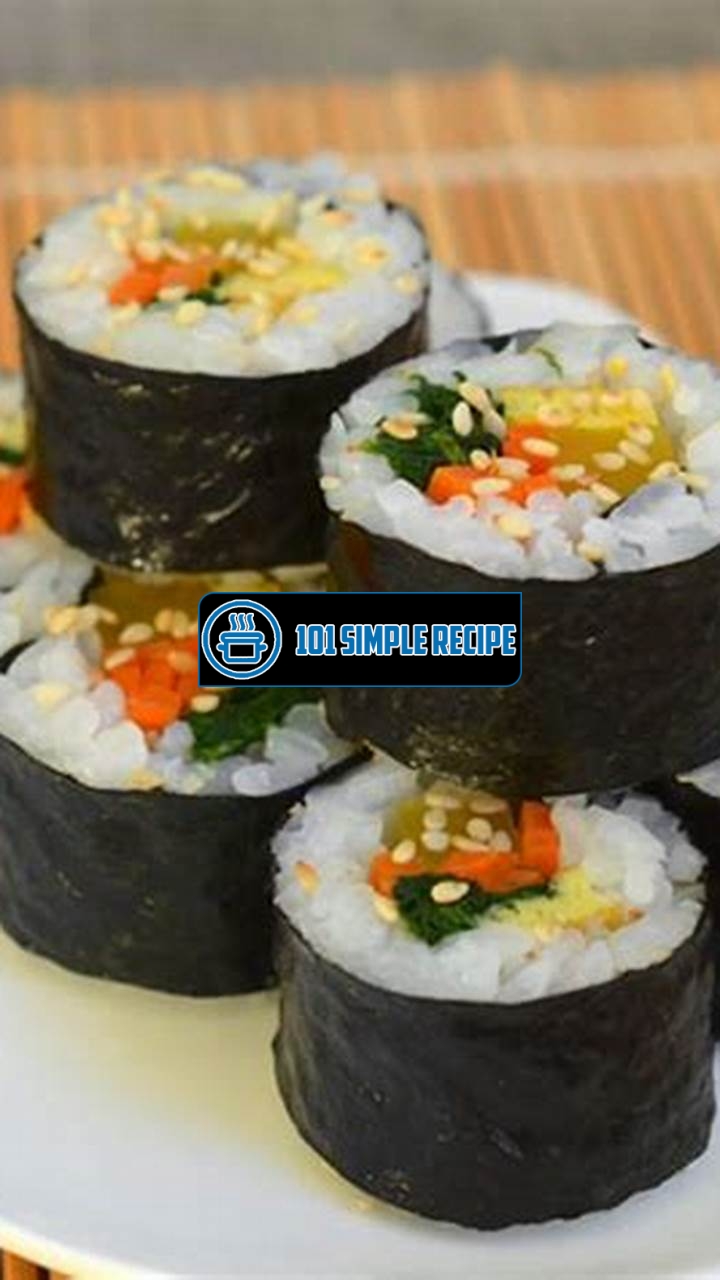Get ready to tantalize your taste buds with the irresistible flavor of Korean Seaweed Rice! With its unique combination of salty seaweed, perfectly seasoned rice, and a hint of sesame oil, this dish offers a burst of umami goodness that will leave you craving for more. Whether you’re a fan of Korean cuisine or simply looking to try something new, this traditional dish is a must-try. To give you a glimpse of its savory goodness, feast your eyes on the image below showcasing a mouthwatering plate of Korean Seaweed Rice.

What is Korean Seaweed Rice?
Korean seaweed rice, also known as gim bap or kimbap, is a popular Korean dish made with seasoned rice and seaweed. It is often enjoyed as a snack or a light meal, and it has gained popularity around the world for its delicious flavor and health benefits. In this article, we will explore the origins and traditional preparation methods of Korean seaweed rice, as well as the numerous health benefits that seaweed provides.
The History of Korean Seaweed Rice
The history of Korean seaweed rice dates back hundreds of years. It is believed to have originated as a portable snack for farmers and fishermen who needed a nutritious and convenient meal to sustain them during their long days of work. Seaweed, which is abundant in the coastal regions of Korea, was readily available and easily preserved, making it an ideal ingredient for creating a filling and satisfying meal.
Over time, seaweed rice evolved from a simple snack into a beloved staple of Korean cuisine. It became a popular dish for special occasions and family gatherings, and its popularity spread throughout the country. Today, Korean seaweed rice is enjoyed by people of all ages and is considered a comfort food that brings back memories of childhood and family meals.
Traditional Ingredients and Preparation
To make Korean seaweed rice, the main ingredients are rice, seaweed, and a variety of fillings. The rice is seasoned with sesame oil, salt, and sometimes sugar to enhance the flavor. The seaweed, known as gim, is toasted and then laid flat on a bamboo mat. The rice mixture is spread evenly onto the seaweed, and fillings such as cooked vegetables, pickled radish, or grilled meat can be added.
Once the fillings are added, the bamboo mat is used to tightly roll the seaweed and rice into a cylindrical shape. The roll is then sliced into bite-sized pieces, revealing the beautiful layers of rice, seaweed, and fillings. The result is a visually appealing and irresistibly delicious dish that can be enjoyed on its own or paired with a bowl of hot soup.
Health Benefits of Seaweed
- Rich in nutrients: Seaweed is packed with essential vitamins and minerals, including iodine, calcium, iron, and vitamins A and C.
- Source of antioxidants: Seaweed contains antioxidants that can help protect the body against oxidative stress and reduce the risk of chronic diseases.
- Good for digestion: The fiber present in seaweed can promote healthy digestion and prevent constipation.
- Supports thyroid function: The iodine content in seaweed is beneficial for maintaining proper thyroid function.
- May aid in weight management: Seaweed is low in calories and fat, making it a healthy choice for those watching their weight.
With its unique flavor and impressive nutritional profile, Korean seaweed rice offers a delightful culinary experience along with numerous health benefits. Whether you are a fan of Korean cuisine or looking to explore new flavors, don’t miss the opportunity to try this irresistible dish. You won’t be disappointed!
Punch bowl recipe is a refreshing and tasty drink that pairs well with Korean seaweed rice. It’s perfect for parties and gatherings.
Types of Korean Seaweed
When it comes to Korean cuisine, one cannot ignore the mouthwatering dish known as Korean seaweed rice. This delightful dish features a perfect balance of flavors and textures, making it a popular choice among food enthusiasts. The key component that gives Korean seaweed rice its distinct taste and appearance is the seaweed. There are several types of seaweed used in Korean cuisine, each with its own unique characteristics. Let’s explore these different varieties and discover what sets them apart.
Nori Seaweed
One of the most widely known and commonly used types of seaweed in Korean cuisine is nori seaweed. Nori seaweed is typically harvested from the ocean and then roasted to perfection. It is usually available in thin, paper-like sheets that are perfect for making sushi rolls or wrapping around rice. Nori seaweed has a slightly salty and slightly sweet taste, which adds depth and flavor to the dish. It also has a crisp texture that provides a satisfying crunch.
Fun Fact: Nori seaweed is extremely nutritious and is a rich source of vitamins and minerals. It is known to be high in iodine, which is essential for thyroid health. Including nori seaweed in your diet can help boost your overall well-being.
Miyeok Seaweed
Another popular type of seaweed used in Korean seaweed rice is miyeok seaweed. Miyeok seaweed, also known as wakame, is often found in Korean soups and stews due to its soft and tender texture. This type of seaweed is typically harvested from the coast and then dried for later use. Miyeok seaweed has a mild and slightly sweet taste that pairs perfectly with the other flavors in Korean seaweed rice. It also adds a delicate and silky texture to the dish, enhancing the overall experience.
Fun Fact: Miyeok seaweed is an excellent source of calcium, iron, and dietary fiber. It is also low in calories, making it a great addition to a healthy and balanced diet.
Dasima Seaweed
The third type of seaweed that is commonly used in Korean seaweed rice is dasima seaweed. Also known as kelp or kombu, dasima seaweed is typically harvested from the ocean and then sun-dried. It is often used to make a savory broth called dashi, which forms the base of many Korean dishes. Dasima seaweed has a strong umami flavor and a slightly chewy texture. When added to Korean seaweed rice, it infuses the dish with a rich and robust taste that is truly irresistible.
Fun Fact: Dasima seaweed contains high levels of iodine and other minerals, making it beneficial for maintaining thyroid function and overall health.
In conclusion, Korean seaweed rice is a delectable dish that showcases the diverse flavors and textures of different types of seaweed. Whether it’s the crispness of nori seaweed, the tenderness of miyeok seaweed, or the umami taste of dasima seaweed, each variety brings its own unique characteristics to the dish. So, the next time you crave a flavorful and satisfying meal, give Korean seaweed rice a try and experience the irresistible combination of seaweed and rice in every bite.
How to Make Korean Seaweed Rice
Learn the step-by-step process of making delicious Korean seaweed rice at home.
Cooking Rice Perfectly
Before you can begin making Korean seaweed rice, it’s important to know how to cook the rice perfectly. The quality of the rice is crucial to achieving the best results in this dish.
Start by washing the rice in cold water until the water runs clear. This step helps remove excess starch from the grains and prevents the rice from becoming sticky. After washing, drain the rice well.
Next, add the rice and the appropriate amount of water to a pot and let it soak for about 30 minutes. This step allows the rice to absorb water evenly, resulting in fluffy and evenly cooked grains.
Once the rice has soaked, bring the pot to a boil over high heat. Then, reduce to low heat and cover the pot. Allow the rice to cook for about 15-20 minutes, or until all the water is absorbed and the rice is tender.
After the cooking time, remove the pot from heat and let it sit for an additional 5 minutes. This resting period allows the steam to further soften the grains and enhances the texture of the rice.
Now that you have perfectly cooked rice, let’s move on to preparing the seaweed.
Preparing the Seaweed
Seaweed is a key ingredient in Korean seaweed rice and provides a unique flavor and texture to the dish. Proper preparation of the seaweed is essential to bring out its best qualities.
Start by selecting high-quality seaweed sheets, also known as gim or nori. Look for sheets that are dark green and have a shiny appearance. Avoid any sheets that are discolored or have a dull appearance as they may have gone bad.
Before using the seaweed, it’s important to gently roast it to enhance its flavor. You can do this by holding the seaweed sheet with tongs and lightly passing it over an open flame or a hot stove burner. Be careful not to burn the seaweed; you just want to toast it slightly until it becomes crisp and fragrant.
Once the seaweed is roasted, break it into small pieces or cut it into thin strips using kitchen scissors. The size of the seaweed pieces can vary depending on personal preference.
Seasoning and Flavorings
The final step in making Korean seaweed rice is to season and add flavorings to the dish. This is where the magic happens and the irresistible flavor of the dish comes to life.
A popular seasoning addition to Korean seaweed rice is sesame oil, which adds a nutty and aromatic taste to the dish. Drizzle a small amount of sesame oil over the cooked rice and gently mix it in to evenly distribute the flavor.
Next, you’ll want to add soy sauce to enhance the savory and umami flavors of the dish. Start with a small amount and add more to taste. Be sure to mix the soy sauce well with the rice to ensure even flavor distribution.
Other optional flavorings you can add include minced garlic, sesame seeds, and chopped green onions. These ingredients provide additional layers of flavor and enhance the overall taste of the Korean seaweed rice.
Now that you’ve seasoned and flavored your rice, take a moment to admire the vibrant colors and enticing aroma of the dish. Korean seaweed rice is now ready to be enjoyed!
Note: Remember to be creative and experiment with different seasonings and flavorings to make the dish your own. Korean seaweed rice is a versatile dish that can be customized to suit individual preferences. Enjoy!
White Castle recipe is a delicious dish that you can try alongside Korean seaweed rice. It’s a popular fast food recipe that you can make at home.
Variations of Korean Seaweed Rice
Discover creative ways to elevate your Korean seaweed rice with additional ingredients and flavors. If you’re a fan of this delicious dish, you’ll be delighted to know that there are numerous variations of Korean seaweed rice that you can explore and enjoy. From adding protein to vegan and vegetarian options, as well as spicy and non-spicy versions, there’s something to suit every taste and dietary preference.
Adding Protein
If you’re looking to incorporate more protein into your diet, you can easily enhance your Korean seaweed rice by adding some protein-rich ingredients. One popular option is to include grilled or sautéed shrimp, which not only provides a tasty flavor but also adds a satisfying crunch. Another protein-packed option is to add thinly sliced beef or chicken, which brings an added layer of savory goodness to the dish. For a vegetarian twist, you can substitute tofu or tempeh, both of which absorb the flavors of the seaweed and seasoning, creating a delicious and nutritious combination.
Vegan and Vegetarian Options
If you follow a vegan or vegetarian lifestyle, there are plenty of options to enjoy a plant-based version of Korean seaweed rice. Instead of animal-based protein sources, you can use plant-based alternatives like tofu, tempeh, or even beans. These ingredients offer a great source of protein and can be seasoned with soy sauce, sesame oil, and other flavorful additions to mimic the taste of traditional seaweed rice. Additionally, you can experiment with different vegetables like mushrooms, carrots, and bell peppers to add texture and enhance the overall flavor of the dish.
Spicy and Non-Spicy Versions
Are you a fan of spicy food? Or perhaps you prefer milder flavors? Either way, there’s a variation of Korean seaweed rice to suit your taste buds. For those who enjoy a little heat, you can add some gochujang, a spicy Korean chili paste, to the rice mixture. This will give your dish a fiery kick and elevate the overall flavor profile. On the other hand, if you prefer a non-spicy version, you can omit the gochujang and focus on the umami flavors of the seaweed and other ingredients. This will result in a milder yet equally delicious version of Korean seaweed rice.
With the variations mentioned above, you can truly make Korean seaweed rice your own. Feel free to get creative and experiment with different ingredients and flavors to discover your favorite combination. Whether you choose to add protein, opt for vegan and vegetarian alternatives, or play with the heat level, your taste buds are in for a treat. So, go ahead and experience the irresistible flavor of Korean seaweed rice!
Coca-Cola cake recipe is a decadent dessert that can be enjoyed after a meal of Korean seaweed rice. It’s rich, moist, and full of chocolatey flavor.
Serving and Enjoying Korean Seaweed Rice
When it comes to Korean cuisine, one dish that stands out for its irresistible flavor and cultural significance is Korean seaweed rice. This delectable dish, also known as “gimbap” or “nori bap,” is a staple in Korean households and is treasured for its unique taste and nutritional value.
Korean Table Manners
In Korean culture, proper table manners are highly valued, and this extends to enjoying Korean seaweed rice. When eating gimbap, it is important to remember a few etiquettes to fully appreciate the dining experience.
- Use chopsticks and a spoon to eat gimbap. The chopsticks are used to pick up the rice rolls, while the spoon is used to enjoy any loose rice that may fall apart.
- Before taking a bite, it is customary to say “Jal meokkesseumnida,” which translates to “I will enjoy this delicious meal.” It is a polite gesture that shows respect for the food.
- Do not bite the gimbap in half. Instead, take small, delicate bites to savor the flavors and textures.
- While eating, avoid talking with your mouth full or making loud chewing noises. Eating quietly is seen as a sign of respect towards others.
By observing these table manners, you can fully immerse yourself in the cultural experience of enjoying Korean seaweed rice.
Accompaniments and Side Dishes
When serving gimbap, it is common to accompany it with a variety of side dishes that complement its flavors and add more depth to the meal. These side dishes, known as “banchan,” can range from pickled vegetables to savory pancakes and soy sauce-based dishes.
Some popular banchan choices to pair with Korean seaweed rice include:
- Kimchi: This fermented cabbage side dish is a staple of Korean cuisine and provides a tangy and spicy kick to balance the flavors of the rice.
- Pickled Radishes: These refreshing and crisp radishes add a delightful crunch to each bite of gimbap.
- Seaweed Soup: A warm bowl of seaweed soup complements the seaweed flavor in the rice rolls, creating a harmonious combination.
- Gyeran-jjim: This fluffy, steamed egg dish adds a creamy and savory element to the meal.
By incorporating these side dishes into your meal, you can elevate the taste of Korean seaweed rice and enjoy a well-rounded dining experience.
Pairing Korean Seaweed Rice with Other Dishes
While Korean seaweed rice is delicious on its own, it can also be paired with other dishes to create a more fulfilling and satisfying meal. The complementary flavors and textures of these dishes enhance the overall dining experience.
Some popular pairings for Korean seaweed rice include:
- Bulgogi: This marinated and grilled beef dish adds a savory and smoky flavor that complements the mild flavors of the gimbap.
- Japchae: A stir-fried noodle dish made with sweet potato noodles, vegetables, and thinly sliced meat. The combination of gimbap and japchae creates a diverse array of flavors and textures.
- Dakgangjeong: Crispy and sweet Korean fried chicken pairs exceptionally well with the umami taste of gimbap.
By experimenting with different combinations, you can find your favorite pairing that celebrates the flavors of Korean seaweed rice and creates a memorable meal.
In conclusion, Korean seaweed rice, or gimbap, is a dish that is deeply rooted in Korean culture and offers an irresistible flavor. By understanding the cultural significance, observing proper table manners, and exploring different accompaniments and pairings, you can fully experience and enjoy the rich and satisfying flavors of Korean seaweed rice.
Thank you for taking the time to read about Korean seaweed rice. We hope you enjoyed learning about this delicious and nutritious dish. If you’re craving the taste of the sea with a hint of umami, then make sure to try out this recipe. Don’t forget to bookmark our page and visit again for more exciting recipes and food articles. See you next time!
Frequently Asked Questions
Here are some frequently asked questions about Korean seaweed rice:
| No. | Questions | Answers |
|---|---|---|
| 1. | What is Korean seaweed rice? | Korean seaweed rice, also known as gim bap or kimbap in Korean, is a popular Korean dish made with seasoned rice and seaweed wrapped around various fillings. |
| 2. | What are the common fillings in Korean seaweed rice? | Common fillings in Korean seaweed rice include vegetables like carrots, cucumber, and spinach, as well as cooked meat or seafood. |
| 3. | Is Korean seaweed rice healthy? | Yes, Korean seaweed rice is considered a healthy dish as it contains whole grains, vegetables, and lean protein. However, the nutritional value can vary depending on the ingredients and portion size. |
| 4. | Can I make Korean seaweed rice vegetarian or vegan? | Absolutely! You can customize your Korean seaweed rice with vegetarian or vegan fillings like tofu, tempeh, or marinated vegetables. |
| 5. | Is Korean seaweed rice gluten-free? | Korean seaweed rice can be gluten-free if you use gluten-free soy sauce and check the labels of other ingredients for potential gluten-containing additives. |
| 6. | How long does Korean seaweed rice last? | Korean seaweed rice is best consumed within a few hours of making it. However, if stored properly in an airtight container in the refrigerator, it can last for up to 24 hours. |
Closing Thoughts
Thank you once again for reading about Korean seaweed rice. We hope you feel inspired to try this flavorful dish in your own kitchen. Whether you’re a fan of Korean cuisine or simply looking for new and exciting recipes to explore, Korean seaweed rice is a must-try. Its combination of textures, flavors, and nutrients will surely satisfy your taste buds. We’ll be back with more culinary adventures, so stay tuned and happy cooking!
Jump to Recipe
Korean Seaweed Rice

Learn how to make delicious Korean seaweed rice at home with this easy recipe. Packed with flavors and nutrients, it’s the perfect dish for any occasion.
- 4 cups cooked short-grain rice
- 4 sheets of roasted seaweed
- 1 carrot (julienned)
- 1 cucumber (julienned)
- 4 eggs (scrambled)
- 8 ounces cooked bulgogi beef or any desired protein
- 2 tablespoons soy sauce
- 1 tablespoon sesame oil
- 1 tablespoon rice vinegar
- Salt and pepper to taste
- Start by cooking the short-grain rice according to package instructions. While the rice is cooking, prepare the fillings by julienning the carrot and cucumber, scrambling the eggs, and cooking the bulgogi beef or your desired protein. Set aside.
- Once the rice is cooked, transfer it to a large bowl. Add soy sauce, sesame oil, rice vinegar, salt, and pepper. Mix well to combine and let the rice cool slightly.
- Lay a sheet of roasted seaweed on a bamboo sushi mat or a clean kitchen towel. Spread a thin layer of seasoned rice evenly onto the seaweed, leaving a small border at the top. Arrange the fillings (carrot, cucumber, scrambled eggs, and bulgogi beef) in a line across the middle of the rice. Using the bamboo mat or towel, tightly roll the seaweed and rice away from you, applying gentle pressure to secure the fillings.
- Once the seaweed rice roll is tightly wrapped, use a sharp knife to slice it into bite-sized pieces. Repeat the process with the remaining ingredients. Serve the Korean seaweed rice rolls with soy sauce or your favorite dipping sauce.






